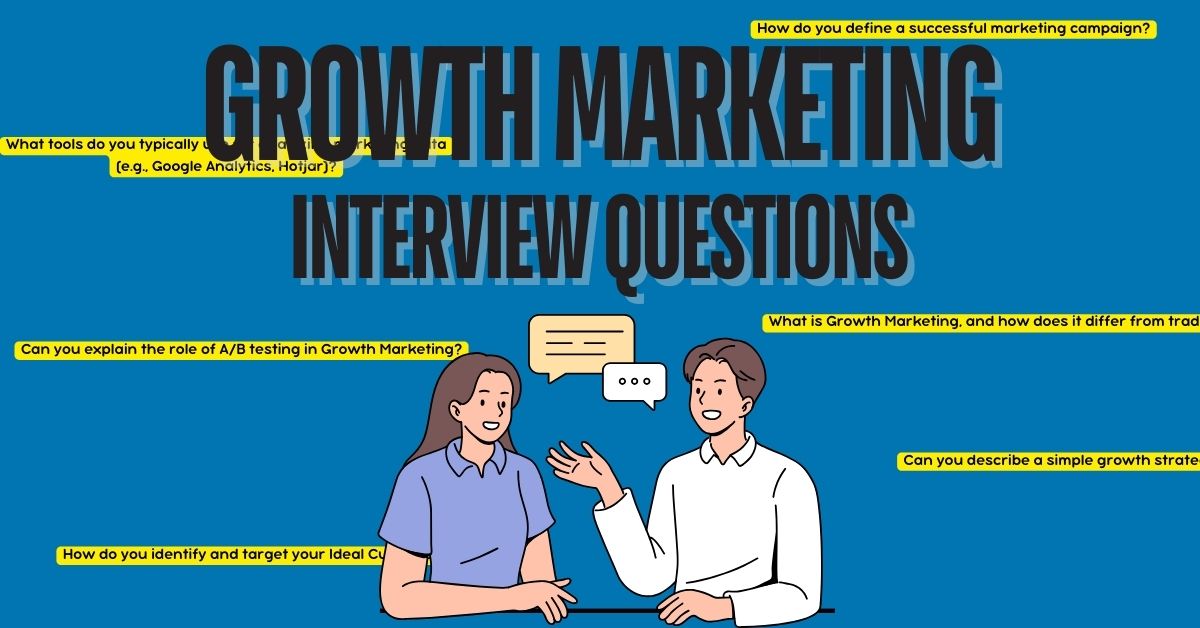Growth Marketing Interview Questions + Answers in 2024
Preparing for a growth marketer interview can be daunting, especially when you’re trying to predict what will be thrown at you.
You may feel pressure to showcase your expertise in digital marketing tools and strategies, or stress about balancing talking through your past successes without sounding boastful. Maybe you’re also trying to keep up with the latest industry trends to show that you’re the perfect fit for the job.
This guide is designed to ease those worries by providing concise, practical tips that help you navigate the complexities of growth marketing interviews.
From understanding fundamental questions to handling in-depth discussions on analytics and strategy, you’ll find ways to articulate your experiences clearly and confidently, ensuring you’re ready to impress your future employer.
What Growth Marketing Interview Questions Do Hiring Managers Often Ask?
Hiring managers frequently ask questions about how candidates have used specific growth strategies in past roles, how they measure and report on campaign success, and how they stay current with digital marketing trends.
But to get an even better idea, consider reading the full list below:
1. What is Growth Marketing, and how does it differ from traditional marketing?
This question is fundamental to understanding the candidate’s awareness of growth marketing as a concept.
Growth marketing extends beyond the boundaries of traditional marketing by focusing on the entire customer lifecycle, from acquisition to retention and everything in between. It often leverages data-driven insights and continuous experimentation to optimize each stage of this journey.
When asked, the interviewer wants to gauge your ability to distinguish between these two approaches and how well you understand growth marketing’s comprehensive scope.
How to Answer
“In traditional marketing, the focus is primarily on acquiring customers through channels like advertising, print media, or online campaigns.
Growth marketing, however, looks beyond acquisition. It involves optimizing each stage of the customer journey, from acquisition to retention, by using data, experimentation, and customer feedback.
Growth marketers continually test and refine strategies to drive sustainable growth, such as A/B testing for better conversion rates or retention tactics like email automation.”
2. Can you explain the role of A/B testing in Growth Marketing?
A/B testing is crucial to growth marketing as it enables marketers to experiment and identify the most effective tactics.
This question checks your understanding of how testing drives decision-making and optimization.
The interviewer wants to see how comfortable you are with the iterative process of testing hypotheses, running experiments, and applying the results to improve campaigns.
How to Answer
“A/B testing allows growth marketers to compare two versions of a marketing asset—such as a webpage, email, or ad—to see which performs better in terms of specific metrics like click-through rates or conversions.
By segmenting users and exposing them to different variations, growth marketers can use data to make informed decisions and refine strategies for optimal results.
This iterative testing process ensures that strategies are based on evidence rather than assumptions.”
3. How do you define a successful marketing campaign?
This question assesses your ability to set and measure campaign objectives effectively.
A successful campaign is usually defined by its alignment with predefined KPIs (Key Performance Indicators), such as customer acquisition cost (CAC), lifetime value (LTV), or engagement rates.
The interviewer wants to see how you evaluate success based on your goals, metrics, and the impact of the campaign on business outcomes.
How to Answer
“A successful marketing campaign is one that meets or exceeds its predefined objectives.
The goals may vary, such as increasing brand awareness, driving website traffic, or boosting customer acquisition. Key metrics could include conversion rates, customer acquisition costs, or ROI.
By continuously monitoring these metrics, growth marketers can evaluate the effectiveness of the campaign and make adjustments as necessary to improve performance.”
4. What tools do you typically use for analyzing marketing data (e.g., Google Analytics, Hotjar)?
Tools are essential in growth marketing to track, analyze, and optimize campaigns.
This question examines your familiarity with key analytics tools that help gather insights about customer behavior, conversion rates, and campaign performance.
The interviewer wants to ensure you are proficient in using data to drive decisions and optimize growth efforts.
How to Answer
“I typically use a combination of tools to analyze marketing data.
Google Analytics provides in-depth insights into website traffic, user behavior, and conversions. Hotjar is useful for understanding how users interact with a site through heatmaps and session recordings.
Additionally, tools like Mixpanel can help track user engagement across different touchpoints, while platforms like HubSpot or Salesforce assist with analyzing customer journeys and CRM data.”
5. Can you describe a simple growth strategy you’ve implemented before?
This question allows the interviewer to evaluate your hands-on experience with growth marketing.
They want to understand your strategic thinking, problem-solving skills, and ability to execute growth initiatives.
Sharing a real-life example demonstrates your ability to implement strategies and measure their impact.
How to Answer
“A simple growth strategy I implemented was focused on optimizing email campaigns for a SaaS product.
After analyzing user data, I identified that the onboarding emails had low engagement rates. I A/B tested different subject lines and adjusted the content to make it more personalized.
This led to a 20% increase in open rates and a 15% improvement in conversion rates for new user sign-ups over the following quarter.”
6. How do you identify and target your Ideal Customer Profile (ICP)?
The Ideal Customer Profile (ICP) is key to any growth strategy because it defines the target audience that will benefit the most from a product or service.
The interviewer wants to assess your ability to conduct research, analyze data, and apply targeting tactics to attract the right audience.
It shows how well you understand customer behavior and market segmentation.
How to Answer
“Identifying and targeting the ICP begins with analyzing both qualitative and quantitative data.
This includes demographic information, customer feedback, and behavioral insights gathered from tools like Google Analytics or CRM platforms.
Once I have this data, I segment the market based on factors like industry, company size, and specific pain points that our product solves.
From there, I refine my targeting strategy through channels that resonate best with this profile, such as personalized email campaigns, targeted social media ads, or content marketing.”
7. What are the key metrics you track in a growth campaign?
Tracking the right metrics is vital to measuring the success of a growth campaign.
The interviewer wants to know which KPIs (Key Performance Indicators) you consider important and how you use these metrics to make decisions and optimize strategies.
Your answer should reflect a data-driven approach to evaluating marketing efforts.
How to Answer
“The key metrics I track in a growth campaign depend on the specific goals of the campaign.
However, common KPIs include Customer Acquisition Cost (CAC), Lifetime Value (LTV), conversion rates, and churn rate. For digital campaigns, I also monitor metrics like click-through rates (CTR), engagement rates, and return on ad spend (ROAS).
By continuously tracking these metrics, I can determine which strategies are most effective and make data-driven adjustments to improve results.”
8. How do you ensure that your growth strategies align with the company’s brand vision?
This question tests your ability to balance data-driven growth tactics with maintaining a company’s brand integrity.
Growth marketing requires constant experimentation, but the interviewer wants to know that you can innovate without straying from the brand’s core identity and values.
How to Answer
“To ensure alignment with the company’s brand vision, I start by clearly understanding the brand’s values, mission, and customer expectations.
I work closely with the brand and creative teams to ensure consistency in tone, messaging, and visual elements across all growth initiatives.
Throughout the campaign, I monitor feedback and engagement to ensure that the audience’s perception of the brand remains positive and in line with our goals.”
9. How do you measure the ROI of a marketing campaign?
Return on Investment (ROI) is a critical measure of a campaign’s financial success.
The interviewer is looking for your ability to evaluate the effectiveness of a marketing initiative in terms of profitability.
This involves not only tracking financial data but also understanding how to attribute results to the right channels.
How to Answer
“To measure the ROI of a marketing campaign, I calculate the total revenue generated by the campaign, subtract the total costs (including ad spend, labor, and resources), and then divide that by the total cost.
I use tools like Google Analytics, HubSpot, or custom dashboards to track attribution and conversions, ensuring that I can attribute revenue to specific channels or campaigns.
This helps in understanding which efforts are the most cost-effective and optimizing future strategies based on those insights.”
10. What is your experience with email marketing platforms?
Email marketing is a powerful tool for engaging and retaining customers, making it a key part of many growth strategies.
The interviewer wants to know if you have hands-on experience with platforms like Mailchimp, HubSpot, or ActiveCampaign, and how effectively you’ve used them to build successful email campaigns.
How to Answer
“I have extensive experience with email marketing platforms such as Mailchimp, HubSpot, and Klaviyo.
These platforms have allowed me to segment audiences, automate email flows, and perform A/B testing to optimize engagement.
For example, I’ve used personalized email sequences to nurture leads through the sales funnel, resulting in higher open and conversion rates.
I also regularly analyze email performance metrics like open rates, click-through rates, and conversion rates to refine my approach.”
11. Can you walk me through a growth campaign that you executed and its outcomes?
This question is designed to gauge your hands-on experience with growth campaigns.
The interviewer wants to see how you approached a project, what strategies you implemented, and what the outcomes were.
It allows you to demonstrate your problem-solving skills, strategic thinking, and your ability to drive measurable results.
How to Answer
“For example, I worked on a growth campaign for a SaaS product that was struggling with user retention.
After analyzing user behavior, we launched an email re-engagement campaign targeting inactive users. We used segmentation to tailor the messaging and A/B tested different email formats. The campaign led to a 15% increase in reactivations and reduced churn by 10%.
This was achieved by personalizing content and providing special incentives to bring users back to the platform.”
12. How do you use cohort analysis to shape your growth strategies?
Cohort analysis helps in understanding user behavior over time, which is vital for crafting long-term growth strategies.
The interviewer is trying to gauge your ability to track customer segments and analyze their behaviors to improve retention, customer satisfaction, or any other critical growth metric.
How to Answer
“Cohort analysis allows me to track specific user groups (or cohorts) based on shared characteristics, such as the date of their sign-up or first purchase.
By comparing how these cohorts behave over time, I can identify trends like when users are most likely to churn or when they engage the most.
For example, I used cohort analysis to track user retention post-onboarding and identified that users who didn’t engage within the first 7 days had a higher churn rate.
This insight led to a targeted onboarding email campaign, improving our retention by 12%.”
13. How do you approach customer segmentation for a new growth initiative?
Customer segmentation is critical for creating targeted and effective marketing campaigns.
The interviewer wants to know how you break down your audience into meaningful segments to deliver personalized experiences that resonate with each group.
They are looking for a solid strategy that blends data analysis with creativity.
How to Answer
“When approaching customer segmentation, I begin by gathering and analyzing both demographic and behavioral data.
I look at user attributes such as age, location, and purchasing behavior, as well as engagement data like how they interact with our product or website.
Based on this, I create distinct segments, such as first-time buyers, repeat customers, or high-value users. From there, I tailor campaigns to each group, ensuring the messaging and offer align with their needs.
For example, in one campaign, I created a segment for high-value customers and offered them exclusive discounts, leading to a 20% increase in revenue from that group.”
14. What methods do you use to gather and incorporate user feedback into your marketing efforts?
User feedback is critical for refining growth strategies, as it offers insights into customer satisfaction, pain points, and preferences.
The interviewer wants to know how you gather feedback, process it, and apply it to improve marketing campaigns and product offerings.
This helps them assess your commitment to user-centric marketing.
How to Answer
“I typically use multiple methods to gather user feedback, including surveys, Net Promoter Score (NPS) tools, customer interviews, and analyzing reviews or social media comments.
Once I gather this feedback, I categorize it to identify recurring themes and pain points.
For example, after launching a new product feature, I used NPS surveys and found that users found it difficult to navigate.
We then made UX improvements based on this feedback, which resulted in a 25% increase in user satisfaction and engagement.”
15. How do you use predictive analytics in growth marketing?
Predictive analytics allows growth marketers to forecast future behaviors and outcomes based on historical data.
The interviewer is assessing your ability to leverage advanced analytical techniques to drive decision-making and growth.
Your answer should showcase your technical expertise in using data to anticipate trends and opportunities.
How to Answer
“Predictive analytics plays a crucial role in optimizing growth strategies by allowing us to anticipate future trends.
I use historical customer data to create predictive models that forecast behaviors like churn, lifetime value, or the likelihood of upsells.
For example, I implemented a predictive analytics model that identified users with a high probability of churn based on their inactivity and purchase history.
We then launched a targeted retention campaign, resulting in a 15% decrease in churn rates within the first quarter.”
16. What frameworks (like RICE, ICE) do you use to prioritize growth initiatives?
Frameworks like RICE (Reach, Impact, Confidence, Effort) or ICE (Impact, Confidence, Ease) are used to prioritize growth initiatives based on their potential value and ease of implementation.
The interviewer wants to understand how you evaluate multiple growth opportunities and decide which ones are worth pursuing.
This question also tests your ability to structure decision-making processes.
How to Answer
“I often use the RICE framework to prioritize growth initiatives.
RICE evaluates each initiative based on Reach (how many users it will affect), Impact (the level of change it will drive), Confidence (how certain we are about the outcome), and Effort (the amount of resources required).
For instance, when working on a product launch, I used RICE to prioritize adding a new feature that would reach 70% of our existing users, had a high impact on user engagement, and required minimal development time.
This allowed us to focus on the highest-impact tasks first, maximizing ROI in the shortest time possible.”
17. How do you optimize paid ad campaigns on platforms like Google Ads and Facebook?
Paid ads are an important component of growth marketing, and the interviewer is interested in understanding your ability to fine-tune ad performance to maximize return on investment (ROI).
They want to know how you monitor, adjust, and improve campaign metrics such as click-through rates (CTR) and conversions.
How to Answer
“Optimizing paid ad campaigns starts with precise audience targeting.
I use a combination of keyword research, A/B testing of ad creatives, and monitoring performance metrics like CTR and cost per acquisition (CPA).
For Google Ads, I regularly adjust bids based on performance, while for Facebook Ads, I focus on retargeting users who have shown interest in the brand.
I also use analytics tools like Google Analytics and Facebook Ads Manager to track conversions and refine the campaigns based on the insights.
By continually testing different ad variations and adjusting budget allocations, I’ve been able to improve ROI by 20-30% in previous campaigns.”
18. How do you track user behavior on a website or app?
Understanding user behavior is essential to optimizing the customer journey and improving conversion rates.
The interviewer wants to know your expertise in tracking user interactions and analyzing this data to make informed decisions.
This question assesses your familiarity with tools like Google Analytics, Hotjar, and Mixpanel.
How to Answer
“I use tools like Google Analytics, Mixpanel, and Hotjar to track user behavior on websites and apps. These platforms allow me to monitor key metrics like bounce rates, session duration, and click paths.
For instance, I set up custom event tracking to monitor when users click specific buttons, scroll through pages, or abandon their carts.
Heatmaps from Hotjar help me visualize where users are most engaged, and funnel analysis from Mixpanel helps identify drop-off points in the conversion process.
This data guides decisions on optimizing landing pages, improving site navigation, or adjusting calls-to-action (CTAs).”
19. How do you approach multi-channel marketing to drive growth?
Multi-channel marketing is essential for expanding reach and creating cohesive customer experiences across platforms.
The interviewer wants to see how you manage campaigns across different channels (e.g., email, social media, paid ads, SEO) and how you ensure consistency while optimizing each channel for growth.
How to Answer
“My approach to multi-channel marketing begins with developing a unified message that resonates with the target audience, regardless of the channel.
I then tailor the content and approach to each specific platform, ensuring the message fits the medium.
For example, I may use Facebook for brand awareness, email marketing for customer retention, and Google Ads for acquisition. I track performance across all channels using tools like HubSpot and Google Analytics to ensure consistency and measure each channel’s contribution to growth.
By integrating insights from these different channels, I can adjust strategies and budgets dynamically to maximize overall campaign effectiveness.”
20. Can you discuss how SEO plays a role in your growth strategy?
SEO (Search Engine Optimization) is a long-term growth strategy that helps drive organic traffic to a website.
The interviewer wants to know your understanding of SEO principles and how you integrate them into your overall growth marketing strategy.
How to Answer
“SEO is a cornerstone of my growth strategy because it helps drive organic traffic with lower long-term costs than paid advertising.
I focus on keyword research, on-page optimization, and creating high-quality content that aligns with user intent.
For example, by optimizing blog content for high-converting keywords, we saw a 25% increase in organic traffic within 3 months. Additionally, I monitor backlinks and site speed, ensuring technical SEO is aligned with best practices.
This holistic approach ensures that we not only improve rankings but also maintain high engagement and conversion rates from organic search traffic.”
21. How do you balance short-term growth initiatives with long-term growth strategies?
Balancing short-term wins with long-term sustainable growth is essential in growth marketing.
The interviewer wants to assess your ability to prioritize initiatives that deliver quick results without sacrificing the company’s broader, long-term goals.
It’s important to highlight your ability to align both types of initiatives with overall business objectives.
How to Answer
“To balance short-term initiatives with long-term strategies, I first ensure that all growth activities are tied to overarching business goals.
For short-term initiatives, I focus on quick wins that drive immediate results, like optimizing paid ad campaigns or running promotional offers. Meanwhile, long-term strategies might include SEO, content marketing, or product development.
By regularly reviewing KPIs and adjusting based on both immediate performance and long-term progress, I ensure that neither aspect is neglected.
For example, while I may run a social media ad campaign to boost sales, I also invest in creating evergreen content that will continuously generate organic traffic over time.”
22. Can you explain a situation where data analysis led you to pivot your strategy mid-campaign?
This question aims to gauge your data-driven decision-making skills and how comfortable you are with changing direction when data indicates that a strategy isn’t working.
Growth marketing often involves trial and error, and the ability to pivot is crucial for success.
How to Answer
“In a recent paid ad campaign, I initially targeted a broad audience to increase reach.
However, after analyzing the first week’s data, I noticed a high click-through rate but a low conversion rate.
I used Google Analytics to dive deeper into user behavior and discovered that users were dropping off after the landing page.
Based on this insight, I pivoted the strategy by narrowing the target audience and redesigning the landing page for a more seamless user experience.
The change improved conversions by 30% in the following weeks.”
23. How do you design and scale growth experiments across multiple channels?
Growth marketing involves constant experimentation, and scaling successful experiments is key to driving growth.
The interviewer wants to understand your process for testing new ideas across different marketing channels and how you scale them once successful.
How to Answer
“I start by designing small, controlled experiments with clear hypotheses and metrics for success.
For example, I may test different ad creatives on Facebook or experiment with email subject lines for open rates. Once I gather data from these tests, I analyze what worked and what didn’t.
Successful experiments are then scaled by applying the learnings across other channels, such as repurposing high-performing Facebook ads for Google Ads or expanding a successful email campaign to include SMS marketing.
Throughout the process, I track performance and iterate to ensure continuous improvement.”
24. Can you explain how you integrate growth marketing strategies across product, marketing, and sales teams?
Growth marketing doesn’t operate in isolation, and collaboration between different departments is vital for success.
This question tests your ability to work cross-functionally and align the objectives of different teams to drive growth.
How to Answer
“I facilitate regular communication and collaboration between product, marketing, and sales teams to ensure alignment on growth objectives.
For instance, the marketing team focuses on generating leads, the product team works on optimizing the user experience, and the sales team converts those leads into customers. I integrate these efforts by setting shared goals, such as improving conversion rates or reducing churn, and organizing joint meetings to review progress.
This holistic approach ensures that all teams are working towards a common goal, allowing for smoother execution of growth initiatives and better results overall.”
25. What’s your approach to building a retention-focused growth strategy, and how do you reduce churn?
Customer retention is often more cost-effective than acquisition, making it an essential part of sustainable growth.
The interviewer wants to know how you create strategies that keep customers engaged over time and how you address churn.
How to Answer
“My retention-focused strategy begins with understanding why customers leave and why they stay.
I conduct churn analysis to identify common pain points and segment customers based on their behavior and needs.
For reducing churn, I implement personalized communication, such as targeted email campaigns for disengaged users or loyalty programs for high-value customers. I also work with the product team to improve the user experience based on customer feedback, and with the customer support team to provide timely resolutions to issues.
By addressing both product-related and communication-related factors, I’ve been able to reduce churn by 15% in previous campaigns.”
26. How do you optimize the entire customer lifecycle, from acquisition to retention?
This question seeks to understand your ability to manage the full spectrum of the customer journey, ensuring that efforts to acquire new users lead to retention and long-term loyalty.
The interviewer wants to see how you connect each phase of the lifecycle and continuously drive growth through optimizations.
How to Answer
“To optimize the customer lifecycle, I focus on building a seamless experience from the first touchpoint to customer loyalty.
For acquisition, I implement targeted campaigns to attract the right audience, utilizing paid ads, content marketing, and social media. Once customers are acquired, I focus on engagement strategies like personalized emails, in-app notifications, and onboarding processes to enhance the user experience.
For retention, I employ tactics like loyalty programs, personalized product recommendations, and proactive customer support. I also track metrics like conversion rates, user engagement, and churn to make continuous improvements at each stage of the lifecycle.”
27. Can you explain how you calculate Customer Lifetime Value (CLTV) and use it to inform growth strategies?
CLTV is crucial in understanding the long-term value of a customer and informs decisions on how much to invest in acquisition and retention.
The interviewer wants to assess your ability to calculate this metric and how you use it to shape your growth strategies.
How to Answer
“I calculate Customer Lifetime Value (CLTV) by analyzing the average purchase value, purchase frequency, and customer lifespan. The formula I use is:
CLTV = (Average Purchase Value) × (Purchase Frequency) × (Customer Lifespan).
For example, if a customer spends $100 per month, makes 12 purchases a year, and stays with the company for 3 years, the CLTV would be $3,600.
This metric helps me determine how much I can spend on acquiring new customers while still ensuring profitability.
If CLTV is high, I may invest more in acquisition channels or focus on retention tactics to further increase value, such as loyalty programs or cross-selling strategies.”
28. How do you balance creativity with data-driven decision-making in your campaigns?
Growth marketing requires a blend of both creative ideas and data-driven insights.
The interviewer wants to know how you strike a balance between developing innovative campaigns while relying on data to inform your decisions.
How to Answer
“I believe creativity and data work hand-in-hand.
When developing campaigns, I start with creative brainstorming sessions to come up with unique ideas that align with the brand’s vision and target audience.
Once I have a concept, I rely on data to refine and validate those ideas.
For example, I may create multiple versions of an ad with different messaging and use A/B testing to determine which one performs better.
Throughout the campaign, I continuously track key performance indicators (KPIs) and adjust based on the data.
This approach allows me to maintain creativity while ensuring that each decision is backed by data to optimize performance.”
29. Can you discuss a complex growth challenge you solved using technical tools like APIs or custom-built analytics platforms?
The interviewer wants to gauge your technical proficiency and how you leverage advanced tools to solve growth challenges.
This question is aimed at understanding your comfort level with more complex growth marketing solutions, such as integrating APIs or building custom analytics dashboards.
How to Answer
“In a previous role, I faced a challenge with tracking user behavior across multiple platforms, including web and mobile.
The existing analytics tools were insufficient for understanding user behavior across devices. To solve this, I worked with the engineering team to implement a custom-built analytics platform using APIs to pull data from multiple sources, including Google Analytics, CRM systems, and our mobile app.
This allowed us to create a unified view of user interactions and better understand the customer journey.
As a result, we were able to optimize our marketing campaigns based on more accurate and comprehensive data, leading to a 20% increase in conversion rates.”
30. What role does mobile marketing play in your overall growth strategy, and how do you measure its impact?
Mobile marketing is increasingly important as more users interact with brands via smartphones.
The interviewer is looking to assess how you integrate mobile strategies into your overall growth plan and what metrics you use to gauge success.
How to Answer
“Mobile marketing plays a crucial role in my growth strategy, as a significant portion of users engage with brands through mobile devices.
I optimize mobile touchpoints, such as responsive websites, mobile apps, push notifications, and SMS marketing, to enhance user experience and increase engagement.
To measure the impact, I track mobile-specific KPIs, such as mobile conversion rates, app installs, in-app purchases, and user engagement metrics.
I also use mobile analytics tools like Firebase or Adjust to monitor how users interact with mobile campaigns and adjust strategies accordingly.
By focusing on mobile user behavior, I can create more personalized and effective marketing efforts that drive growth.”
How to Prepare for a Growth Marketer Interview
Now that you’ve grasped some ideas that may be asked in a growth marketing interview, use the tips below to further help you pass it:
Understand the Company and Its Growth Channels
Research the company thoroughly to understand its growth channels, key products, market position, and competitive landscape. Analyze their website, review any available case studies, press releases, and social media activity to get a sense of their marketing strategies and company culture.
Review Common Growth Marketing Questions
Familiarize yourself with typical growth marketing interview questions. This includes understanding how to demonstrate your ability to use data in crafting growth strategies, your experiences with A/B testing, funnel optimization, and how you’ve successfully driven past marketing campaigns.
Prepare to Discuss Key Metrics and Strategies
Be ready to discuss how you measure the success of growth initiatives, including familiarity with KPIs like customer acquisition cost, lifetime value, and engagement metrics. Prepare to explain how these metrics guide your marketing strategies and decision-making processes.
Highlight Your Analytical and Creative Skills
Growth marketing requires a blend of creativity and analytical skills. Prepare examples where you’ve successfully used both to drive growth. This could be how you’ve managed A/B testing, data analysis, content strategy, and how you’ve adapted strategies based on analytics insights.
Stay Updated and Show Enthusiasm for Continuous Learning
Demonstrate your commitment to staying updated with the latest marketing tools, trends, and strategies. Mention specific resources you use, such as industry blogs, newsletters, and webinars. Showing your proactive approach to learning and adapting can be very appealing to potential employers.
Conclusion
By following these tips, you can demonstrate a thorough understanding of growth marketing and show that you are well-prepared to contribute effectively to potential employers’ success.
If you want to explore more interview topics, check out our Interview Question Section where we’ve also covered areas like ‘Sales’ and Graphic Design Interview Questions.
If you’re interested in reading more from us, visit our blog where we’ve discussed ‘Data Driven Design‘, ‘Best Copywriting Tips‘, and much more.
As always, if you have any questions about this topic, don’t hesitate to reach out!
FAQs
How can I demonstrate my expertise in growth marketing during an interview?
During your interview, present specific case studies or examples from your past experiences that showcase your ability to drive growth. Highlight your role in the project, the strategies you implemented, the tools you used, and the outcomes. Use metrics to quantify your achievements, as this makes your contribution clear and measurable.
What are some common mistakes to avoid in a growth marketing interview?
Common mistakes include not being able to explain the rationale behind certain strategies, not being familiar with the latest tools and techniques, and failing to align your answers with the company’s specific needs and goals. Avoid generalities by preparing tailored responses based on the company’s industry, size, and market position.
How should I prepare for technical questions in a growth marketing interview?
Refresh your knowledge on key analytical tools like Google Analytics, SQL, or any other specific platforms mentioned in the job description. Be prepared to discuss how you use these tools to drive decisions and measure outcomes. If possible, get certified in these tools if you aren’t already, as this can serve as a concrete demonstration of your skills.
Can you provide tips on how to effectively communicate my growth marketing strategy during an interview?
Structure your communication to first outline the situation or task, then the action you took, and finally the result (the STAR method). This framework helps keep your explanation concise and focused on outcomes. Additionally, practicing your responses with a peer or mentor can help you refine your delivery and ensure clarity.
What questions should I ask the interviewer to demonstrate my interest in the role?
Ask insightful questions that show your understanding of growth marketing and your eagerness to contribute to the company. For example, inquire about the biggest challenges their marketing team is currently facing, what a typical campaign cycle looks like, or how they measure success in growth marketing initiatives. This shows your proactive thinking and engagement with the role.






![30 Conversion Rate Optimization Interview Questions [ANSWERED]](https://www.juanremotework.com/wp-content/uploads/2024/07/a-person-getting-interviewed-768x402.jpg)
